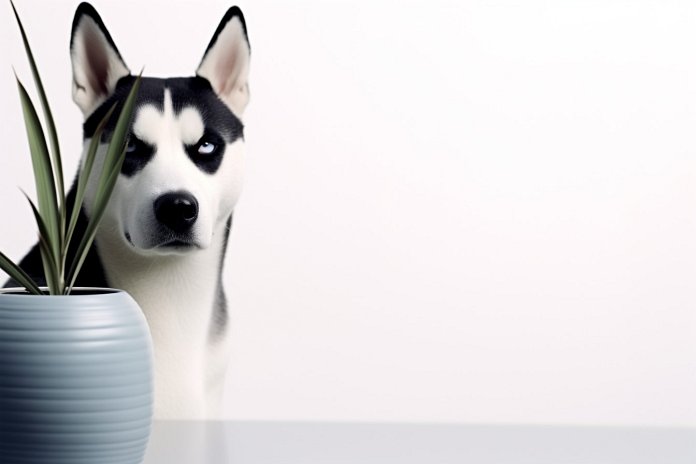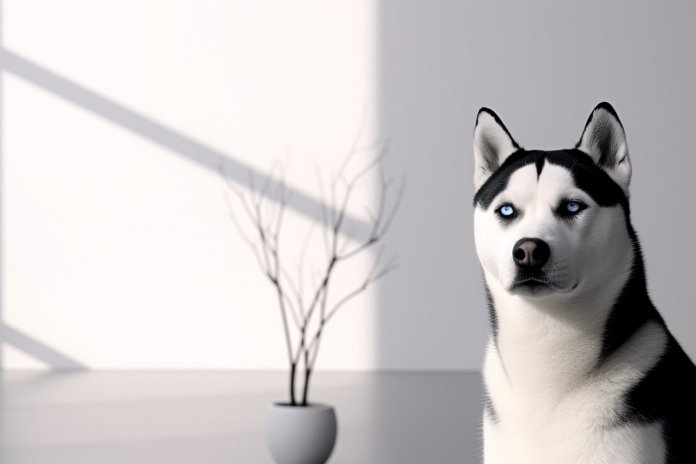
The Boxsky is a highly energetic and hyperactive breed that craves constant attention and affection from its family. It is a mix of the Boxer and the Siberian Husky, resulting in a unique and inspiring breed. While the exact origin of the Boxsky is uncertain, it is believed to have been developed relatively recently.
One notable characteristic of the Boxsky is its tendency to be quite noisy as it tries to grab people’s attention. This, combined with its vigilant nature, makes it an excellent watchdog. With its curious attitude, the Boxsky always remains aware of its surroundings and is quick to spot any unusual behavior.
In terms of grooming, the Boxsky has a mostly short yet thick coat, which makes it relatively easy to care for. However, due to its high energy levels, this breed requires a significant amount of playtime every day. Providing ample exercise and mental stimulation is essential to keep the Boxsky happy and healthy.
Below, we look at Boxsky dog breed, its history, personality, pros and cons of owning an Boxsky, characteristics, and must-see facts. We will also examine how to care for this breed and more. Prepare for a tail-wagging adventure into the world of Boxskys!
| Dog Breed | Boxsky |
| Size | Medium |
| Weight | 35-75 lbs (average) |
| Height | 20-35″ (average) |
| Location | Unknown |
| Ancestry | Boxer, Siberian Husky |
| Date of Origin | Unknown |
| Group | Companion, Watchdog |
| Life Expectancy | 12-14 years |
| Price | $600 – $1200 |
| Family | Canidae |
| Scientific Name | Canis Lupus Familiaris |
📖 Breed History
The Boxsky is a breed that originated from a mix of the Boxer and Siberian Husky. The exact development of the Boxsky breed is unknown, but both parent breeds have interesting histories. The Boxer was originally developed in Germany during the late 19th century from a hunting dog called the Bullenbeisser. This dog was used for hunting bear, wild boar, and deer, and would hold onto the prey until hunters retrieved it. The Boxer breed was stabilized and a dog show exhibition was developed in the late 19th century. It was introduced to other parts of Europe and eventually imported to the United States in the 20th century. The Boxer played various roles in the military during World War I and gained popularity after World War II when soldiers brought them home as mascots.
The Siberian Husky, on the other hand, is a medium-sized working dog that originated in Siberia, Russia. They belong to the Spitz genetic family and were bred for pulling sleds over long distances. They were known for their energy and escapability, often finding ways to dig themselves out of sturdy fences. The Siberian Husky gained attention in the Alaska Sweepstake Race of 1909 due to its incredible endurance. It was officially recognized by the American Kennel Club in 1930 and has become the 12th most popular breed on the list.
In summary, the Boxsky is a mix of the Boxer and Siberian Husky breeds. The Boxer has a rich history in Germany, while the Siberian Husky originated in Siberia and gained recognition for its sled-pulling abilities. Both parent breeds have interesting backgrounds and contribute unique traits to the Boxsky breed.

🐕 Boxsky Appearance
In terms of looks, the Boxsky and Boxer are very similar. The size of this dog’s body can range from modest to huge. It assumes an attentive and enquiring posture. The breed can have the Siberian Husky’s piercing blue eyes, but most of them have brown eyes. The color of its short to medium-length coat can range from tan to fawn to white with black. The Siberian Husky’s coat is also renowned for taking on a more dense-like texture and for being water-repellent. Ears might be straight or can be droopy. The tail often has a short coat and is full. The Boxsky is 20 to 35 inches tall and weighs between 35 and 75 pounds. Height, weight, and look might vary from litter to litter for any one dog.
| 👀 Eye Color | Blue |
| 🐽 Nose Color | Black |
| 🐕 Coat Color | White, Black, Fawn |
⚡ Fun Fact: Boxsky dogs are a social breed. They enjoy being around people or other animals. This breed doesn’t tolerate being left alone.
🐶 Traits & Temperament of Boxsky
Due of the characteristics of the Siberian Husky, the Boxsky is thought to have unusually high activity levels. This extremely spirited breed needs frequent exercise since it will bounce off the walls if not given care. This energetic dog wants frequent interaction from its owners and adores being active. If not given early training, the Boxsky could be wary of strangers. The protective parent Siberian Husky is a circumspect dog. The Boxsky is no exception and may make an excellent guard dog; early training will enable this breed to differentiate between a welcome visitor and an invader. Families with older children should avoid this driven dog since his energy can be too much for them to manage. It is a very loud breed that will require persistent but strong training in order to reduce the frequency of barking. To get along with both dogs and other animals, the Boxsky has to be socialized as a puppy. This sophisticated breed will profit from rewards like snacks and positive reinforcement, despite its intelligence.
🤝 Are Boxskys Friendly or Aggressive?
Boxsky dogs tend to have difficulties getting along with other pets, but they are generally friendly towards strangers. They are also known to be kid-friendly, making them a suitable option for families with children. However, Boxskys may not be the most compatible with cats. On the other hand, this breed is dog-friendly, making them a good choice for those looking to have multiple dogs or participate in dog meetups. Additionally, Boxskys are often recommended for elderly individuals.
This breed is known for being:
- Playful
- Energetic
- Alert
- Intelligent
- Confident
- Friendly
- Outgoing
- Loyal
- Gentle
- Fearless
- Brave
- Bright
🐩 Boxsky Care & Maintenance
The Boxsky sheds a lot and is not regarded as a hypoallergenic breed. Because of the frequent coat blowouts, this breed is not suggested for those who suffer from allergies. A rubber curry brush used daily can help get rid of most of the dead hair. When the shed is at its worst, a slicker brush and a deshedding tool will be useful. This hybrid won’t need to be washed frequently because it doesn’t drool. However, his nails should not be ignored and he should wash his teeth at least twice to three times a week. Check them often for cracks or rips. If your Boxsky enjoys being in the water, make sure to rinse his ears completely after swimming to prevent wax accumulation.
Boxsky dogs are known to shed more hair than the average dog. This shedding is a normal part of their hair growth cycle. The amount and frequency of hair loss can vary depending on the dog’s health and breed. If you’re not a fan of constantly vacuuming up dog hair, you might want to think twice about getting a Boxsky puppy. Additionally, it is recommended to give Boxsky dogs a bath every 3-4 weeks to keep their coat clean and healthy.
🍖 Food: We recommend 3 cups daily, costing you about $1.50 – $1.90 daily, or approximately $39.00 – $52.00 a month.
🐾 Exercise: Boxsky dogs need quite a lot of exercise. Daily walks should be on schedule. If you live an active life, this breed can be a good choice for you.
This dog breed requires to be walked for roughly 14 miles per week, which equates to about 80 minutes of physical activity daily. This consistent moderate exercise regimen will help maintain their physical wellness and significantly contribute to their mental stimulation. Consciously setting aside this time for your furry friend can dramatically enhance their life quality, helping them stay energetic, healthy, and mentally alert.
Did you know: Boxsky dogs are high-energy dogs. An active lifestyle makes them happy.
❤️🩹 Boxsky Health & Issues
Some of the major concerns for Boxsky Dog Breed can be:
- Hip Dysplasia
While minor concerns include:
- Usually Very Healthy
🤧 Important: Is Boxsky hypoallergenic? No.
✨ Bonus: Check out cool, creative, and funny names for Boxsky.
⚡ Boxsky Dog Breed Facts
What makes the Boxsky a great choice for families with young children?
The Boxsky is not a great choice for families with young children because its exuberance and high energy levels may be too much for them to handle.
Is the Boxsky breed considered a suitable breed for apartment living?
The Boxsky is not considered a suitable breed for apartment living due to its highly energetic and hyperactive nature. It requires a lot of space to run and play.
How much exercise does a Boxsky require compared to other breeds?
The Boxsky requires a significant amount of exercise compared to other breeds. Its high energy levels and need for constant activity make it necessary to provide immense amounts of play per day.
Is the Boxsky breed known for being good with other pets?
The Boxsky can be good with other pets if it is properly socialized as a puppy. Early training and socialization will help it be friendly with other dogs and animals.
What are other low-maintenance dog breeds similar to the Boxsky?
Some low-maintenance dog breeds similar to the Boxsky include the Labrador Retriever, Beagle, and Cavalier King Charles Spaniel. These breeds have lower exercise and grooming needs compared to the Boxsky.
What are the common health issues that Boxskys are prone to?
Common health issues that Boxskys are prone to include hip dysplasia, allergies, and eye problems. Regular vet check-ups and proper care can help prevent or manage these issues.
Are Boxskys known to be easy to train compared to other breeds?
Boxskys are known to be intelligent and trainable, but they may benefit from positive reinforcement and rewards. Consistent but firm instruction can help decrease the frequency of barking and enhance their trainability.
Are Boxskys more prone to separation anxiety compared to other breeds?
Boxskys may be more prone to separation anxiety compared to other breeds due to their strong attachment and need for constant attention. Proper training and gradual desensitization can help manage this issue.
Are there any dog breeds similar to the Boxsky that are suitable for people with allergies?
Some dog breeds similar to the Boxsky that are suitable for people with allergies include the Poodle, Bichon Frise, and Portuguese Water Dog. These breeds have hypoallergenic coats that produce fewer allergens.
What sizes of dogs similar to the Boxsky are best for individuals or families with limited space?
Smaller sizes of dogs similar to the Boxsky, such as the Miniature Boxsky or the Toy Boxsky, are best for individuals or families with limited space. These smaller breeds still possess the Boxsky’s energetic and hyperactive nature but require less space.
Is the Boxsky breed known to be good with children with special needs?
The Boxsky breed can be good with children, including those with special needs, if properly trained and socialized. However, due to its high energy levels, it is important to supervise interactions between the dog and children to ensure safety.
How does the grooming and shedding needs of the Boxsky?
The grooming and shedding needs of the Boxsky are relatively low compared to other breeds. Its short but dense coat requires minimal maintenance, making it easier to care for in terms of grooming and shedding.
We use reliable and publicly available data and resources such as AKC and American Canine Registry to ensure that Boxsky dog breed information is accurate and up to date. If you spot an error, please don’t hesitate to bring it to our attention.